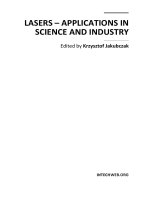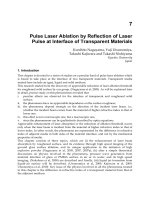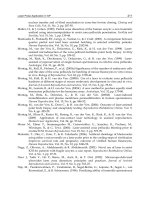MATHEMATICAL METHOD IN SCIENCE AND ENGINEERING Episode 11 ppt
Bạn đang xem bản rút gọn của tài liệu. Xem và tải ngay bản đầy đủ của tài liệu tại đây (3.09 MB, 40 trang )
COMPLEX TECHNIQUES IN TAKING SOME DEFINITE INTEGRALS
353
a>
1.
d8
'7r
I=J~
a+cose'
Using Equations (13.86) and (13.87) we can write this integral as
I=
-i
dz
(13.89)
(13.90)
The denominator can be factorized as
(2
-
a)
(z
-
P)
i
(13.91)
where
a
=
-a
+
(2
-
I)
4
,
(13.92)
p
=
-a
-
(a2
-
1) .
(13.93)
1
For
a
>
1 we have
la1
<
1
and
101
>
1;
thus only the root
z
=
a
is
present inside the unit circle. We can now
use
the Cauchy integral
theorem to find
1
I
=
-2i
(274
-
a-P
(13.94)
(13.95)
Example
13.5.
Cornplea: contour integml technique:
We now consider
the integral
We can use Equations (13.86) and (13.87) to write
I
as
a contour integral
over the unit circle
as
(13.96)
We can now evaluate this integral by using the residue theorem as
I=
(-')'
(-2'2~2
[
residue
of
:
(z
-
:)
''
at
z
=
0
]
.
(13.97)
2a
22'
354
COMPLEX INTEGRALS AND SERIES
Using the binomial formula we can write
(13.98)
z
k=O
where the residue we need
is
the coefficient
of
the
1/z
term. This can
be
easily found
as
and the result
of
the definite integral
I
becomes
(21)!
221
(l!)2.
I=
-
fig.
13.13
Contour
for the
type
I1
integrals
11.
Integrals
of
the type I
=
s_”,
dxR
(x)
,
where
R
(x)
is
a
rational function
of
the form
ao
+
a*x+
U2Z2
+.
.
.
+
a,xn
R(x)
=
bo
+
biz
+
b2x2
+.
.
.
+
bmxm
’
a
)
With no singular points on the real axis,
b
)
IR
(z)l
goes
to
zero at least
as
-
in the limit
as
IzI
+
00
.
1.
1z21
(13.99)
(13.100)
(13.101)
Under these conditions
I
has the same value with the complex contour
integral
I
=
R
(z)
dz,
COMPLEX TECHNIQUES IN TAKING SOME DEFINITE INTEGRALS
355
fig.
13.14
Contour
for
Example
13.6
where
C
is
a
semicircle in the upper half
of
the z-plane considered in
the limit
as
the radius
goes
to infinity (Fig.
13.13).
Proof is fairly
straightforward if we write
I
as
I=h
R(z)dz
=lmR(x)dz+i
R(z)dz
(13.102)
and note that the integral over the semicircle vanishes in the limit
as
the radius
goes
to infinity.
We
can now evaluate
I
using the residue
theorem.
03
Example
13.6.
Complex contour integral technique:
Let us evaluate
the integral
dx
n
=
1,2,
(1
fX2)"
(13.103)
Since the conditions of the above technique are satisfied, we write
I=f
dz
c
(z+2)n(z-2)n-
(13.104)
Only the singular point
z
=
2
is inside the contour
C
(Fig.
13.14);
thus
we can write
I
as
)
at
z
=
21.
(13.105)
(2
+
2)"
(z
-
2)"
To
find the residue we write
m
(13.106)
__
(13.107)
k
=
XAk
(z
-
2)
k=O
356
COMPLEX INTEGRALS AND SERIES
fig.
13.15
Contour
C
in the limit
R
-+
00
for
type
I11
integrals
and extract the
An-l
coefficient
as
(13.108)
n(n+
1)
(n
+
2).
(2n
-
2)
(-
l)n-
1
-
(n-
I)!
(z
+
i)2n-
I=&.
This gives the value
of
the integral
I
as
(13.109)
27ri
(-1)-
'
(2n
-
2)!i
I=
(n
-
I)!
22n-1
(n
-
I)!
111.
Integrals
of
the type
I
=
s-ma
dxR
(z)
einz,
where
K.
is a real parameter and
R
(x)
is a rational function with
a
)
No
singular points on the real axis,
b
)
In the limit
as
IzI
+
00,
IR
(.)I
-+
0
independent
of
8.
Under these conditions we can write the integral
I
as the contour integral
I
=
R(z)
einzdz,
(13.110)
where the contour
C
is shown in Figure 13.15.
To
show that this is true,
we
have to show the limit
R(z)
einzdz
+
0.
(13.111)
We
start by taking the moduli
of
the quantities in the integrand to put
an upper limit to this integral as
I
IpieiOI
a.
(13.112)
COMPLEX TECHNIQUES IN JAKtNG SOME DEFINITE INTEGRALS
357
fig.
13.16
Upper
limit
calculation
We now call the maximum value that
R(z)
takes in the interval
[0,2w]
M
(P)
=
m=
IR
(211
(13.113)
and improve this bound as
(13.115)
Since the straight line segment shown in Figure
13.16,
in the interval
[0,7r/2]
,
is
always less than the sin
6
function, we can also write Equation
(13.115)
as
IA
5
2pM (p)
1%
e-2np$d3.
(13.116)
0
This integral can easily be taken to yield
(13.117)
(13.118)
From
here we see that in the limit
as
p
t
(~f
the value of the integral
IA
goes to zero, that
is,
7F
IA
5
2pM (p)
-
(1
-
ePnp)
,
ZA
5
M
(p)
lc
(1
-
epnp).
2KP
?r
This result is
also
called
Jordan's
lemma.
358
COMPLEX
INTEGRALS AND SERIES
Example
13.7.
Complex
contouy integral technique:
In calculating
dis-
persion relations we frequently encounter integrals like
la
f
(z)
=
-
1
dkg (k)eikx.
6
-a
Let
us
consider
a
case where
g
(k)
is given
as
i
)
For
x
>
0
we can write
(13.119)
(13.120)
(13.121)
In this integral
k
is now
a
point in the complex k-plane. Because we
have
a
pole
(k
=
ip)
inside our contour, we use the Cauchy integral
theorem
[Eq.
(13.6)]
to
find
ii
)
For
z
<
0,
we complete our contour
C
from below
to
find
(13.122)
(13.123)
(13.124)
(13.125)
IV.
Integrals
of
the type
I
=
s,"
dzzX-l
R
(z),
where
a)
X
#
integer,
b)
R(z)
is
a
rational function with no poles on the positive real axis and
the origin,
c)
In the limit
as
121
-+
0,
lzXR
(z)I
-+
0
and
d)
In the limit
as
121
-+
00
,
IzXR(z)l
+
0.
COMPLEX TECHNIQUES IN TAKING SOME DEFINITE INTEGRALS
359
Fig.
13.17
Contour
for
the integrals
of
type
IV
Under these conditions we can evaluate the integral
I
as
(13.126)
7r
(-1y
residues of
[zA-
'
R
(z)]
,
- -
sin
7rA
inside
C
where
C
is
the closed contour shown in Figure 13.17
Proof:
Let us write the integral
I
as
a
complex contour integral:
i
zX-'R
(z)
dz.
In the limit
as
the radius of the small circle
(13.127)
goes to zero the integral
over the contour
Ci
goes
to
zero because
of
c.
Similarly, in the limit
as
the radius
of
the large circle goes to infinity the integral over
Co
goes to
zero
because of
d.
This leaves
us
with
We can now evaluate the integral
on
the left-hand
side
by using the
residue theorem. On the other hand, the right-hand side can be written
360
COMPLEX
INTEGRALS AND SERIES
as
f
zX-'R(z)dz
*L1++L2
=
xX-l
R
(x)
d~
(13.128)
Thus
we
obtain
27ri
residues of
[z'-'R(z)]
inside
C
dxxx-'
R
(x)
.
(13.130)
Rearranging this, we write the final result
as
7r
(-1y
residues of
[zX-'R(z)]
.
sin
7rX
inside
C
(13.131)
13.8 GAMMA AND BETA FUNCTIONS
13.8.1 Gamma Function
For
an important application of the type
IV
integrals
we
now introduce the
gamma and beta functions, which are frequently encountered in applications.
The gamma function
is
defined for all
x
values as
I-
N! N"
X[Z
+
1][~
+
21
. .
.
[X
+
N]
r(x)
=
lim
(13.132)
Integral definition of the gamma function, even though restricted to
x
>
0,
is
also very useful:
r
(x)
=
Lmyz-'
exp(-y)dy.
(13.133)
Using integration by parts we can write this as
GAMMA AND BETA FUNCTIONS
361
PW
(13.134)
(13.135)
This gives us the formula
r
=
(.
-
i)r
(x-
I),
(
1
3.136)
which is one of the most important properties of the gamma function.
For
the positive integer values of
x,
this formula gives us
(13.137)
(13.138)
(13.139)
Besides,
if
we write
we can
also
define the gamma function for the negative integer arguments.
Even though this expression gives infinity for the values of
r
(0)
,
r
(-1)
and
for all the other negative integer arguments, their ratios are finite:
r(-n)
-
[-N] [-N+
11
.
[-N
-
21
[-N
-
11
r
(-N)
For
some
n
values, the gamma function takes the values:
I
r(-$)=
QJiF
I
r(i)=i
I
I
r(-1)
=
*OO
I
r($)
=
$&
I
The inverse of the
finite with the limit
(13.140)
gamma function,
l/r
(x)
,
is
single valued and always
(13.141)
362
COMPLEX INTEGRALS AND SERIES
13.8.2
Beta
Function
Let
us
write the multiplication of two gamma functions
as
r(n
+
1)
r
(m
+
1)
=
e-"u"d~]~ e-"vmdv.
lo
Using the transformation
u
=
x2
and
v
=
y2,
we can write
13.142)
13.143)
In plane polar coordinates this becomes
r(n+i)r(m+i)
(13.145)
The first term on the right-hand side is
r
(m
+
n
+
2)
and the second term is
called the beta function
B
(m
+
1,
n
+
1).
The beta function is related to the
gamma function through the relation
(13.146)
Another definition of the beta function is obtained by the substitutions
sin2
8
=
t
(13.147)
and
as
(13.148)
X
t=-
1-2
xmdx
00
.I
(1
+
x)m+n+2.
B(m+
l,n+
1)
=
(13.149)
GAMMA AND BETA FUNCJIONS
363
Using the substitution
Y
x=-
1-y'
(13.150)
we can also write
,,I
To calculate the value of
B(;,$)
we
have
to
evaluate the integral
11
Using formula (13.131) we can evaluate this as
(13.152)
(-
1)-
W(-
1)
-
1/2
-7r
-
-
sin
7r/2
=
7r.
(13.153)
From here we obtain
1
r($
=
6'
(13.154)
(2n)!
J;;
4"n!
'
1
2
r(-
+
n)
=
~
1
(-4)"n!fi
r(-
-
n)
=
2
(2n)!
.
Another useful function related to the gamma function
is
given
as
(13.155)
(13.156)
(13.157)
The function
9(z)
satisfies the recursion relation
@(x
+
1)
=
9(z)
+
2-1,
(13.158)
from which we obtain
(13.159)
@(n+1)=@(1)+C7.
"1
j=1
3
The value of @(l) is given in terms of the Euler constant
y
as
-9(l)
=
7
=
0.5772157.
(13.160)
364
COMPLEX INTEGRALS AND SERIES
13.8.3
Among the useful relations
of
the gamma function we can write
Useful Relations of the Gamma Functions
-7r
csc(7rx)
r(x
+
1)
’
r(-x)
=
~T(x)~(x
+
3)
26
’
r(2~)
=
In calculating ratios like
the ratio
(13.161)
(13.162)
(13.163)
(13.164)
(13.165)
is very useful.
5’:”’
are the Stirling numbers of the first type:
S(”)
3+1
=
s(m-1)
3
-jsy4,
$0)
=
1
(13.166)
and for the others
sp
=
sy
=
0.
(13.167)
In terms of the binomial coefficients this ratio can also be written as
(13.168)
13.8.4
Both the beta and the gamma functions have their incomplete forms. The
definition of the incomplete beta function with respect to
x
is
given as
Incomplete Gamma and Beta Functions
(13.169)
CAUCHY PRINCIPAL VALUE INTEGRAL
365
On the other hand, the incomplete gamma function
is
defined by
y*
(c,
X)
=
-
y("-')
exp(
-y)dy
r(x)
c-x
IC
0
(13.170)
(13.171)
In this equation
y*
(c,
z)
is
a
single-valued analytic function of
c
and
z.
Among
the useful relations of
y*(c,
z)
we can give
(13.172)
(13.173)
13.9
CAUCHY PRINCIPAL VALUE INTEGRAL
Sometimes we encounter integrals with poles on the real axis, such
as
the
integral
(13.174)
which is undefined (divergent) at
z
=
a.
However, because the problem is
only at
x
=
a,
we can modify this integral by first integrating up
to
an
infinitesimally close point,
(a
-
a),
to
a
and then continue integration on the
other side from an arbitrarily close point,
(a
+
S),
to infinity, that
is,
define
the integral
I
as
(13.175)
This is called taking the
Cauchy
principal
value
of the integral, and it is
shown
as
If
f
(z)
is
analytic in the upper half z-plane, that is
as
IzI
+
00,
f(z)
-+
0
for
y
>
0,
(13.176)
366
COMPLEX INTEGRALS AND SERIES
t'
fig.
13.18
Contour
G
for
the Cauchy principal value integral
we can evaluate the Cauchy principal value
of
the integral (13.174) by using
the contour in Figure 13.18. In this case we write
(13.177)
and evaluate this integral
by
using the residue theorem as
dz
=
27~2
residues
of
[
z]
.
(13.178)
If
f(z)/(z
-
u)
does not have any isolated singular points inside the closed
contour
C
[Fig.
13.181, the left-hand side
of
Equation (13.177)
is
zero, thus
giving the Cauchy principal value
of
the integral (13.175)
as
inside
C
(13.179)
f-
From the condition
f
(z)
+
0
as
IzI
-+
00
for y
>
0,
the second integral over
CR
on
the right-hand side
is
zero.
To
evaluate the integral over the small arc
c6
we write
(13.180)
(13.181)
CAUCHY PRINCIPAL VALUE INTEGRAL
367
tz
Fig.
13.19
Another path
for
the Cauchy principal value calculation
and find the Cauchy principal value
as
(13.182)
(13.183)
Another contour that we can use to find the Cauchy principal value
is
given
in Figure
13.19.
In this case the pole
at
x
=
u
is inside our contour. Using
the residue theorem we obtain
=
-27rf
(u)
+
2nif
(u)
=
i?rf
(u)
.
(13.184)
As expected, the Cauchy principal value
is
the same
for
both choices of detour
about
z
=
u
.
If
f
(z)
is analytic in the lower half of the z-plane, that is,
f(z)
+
0
as
IzI
-+
03
for
y
<
0,
then the Cauchy principal value
is
given
as
(13.185)
In this case we again have two choices for the detour around the singular
point on the real axis. Again the Cauchy principal value is
-ixf(u)
for both
choices.
368
COMPLEX
INTEGRALS AND SERIES
Z
-kr
kr
fig.
13.20
Contour
for
11
Example
13.8.
Cauchy principal value integral:
Let
us
now evaluate the
integral
(13.186)
We write
I
as
I
=
I1
+
12,
where
xeixdx
(13.187)
(13.188)
(x
-
kr)
(x
+
kr)'
For
I1
we choose
our
path in the z-plane as in Figure 13.20 to obtain
lr
=
-
cos
kr.
2
t=-kr
11
(13.189)
For the integral
I2
we use the path in Figure 13.21
to
obtain
m
=
1
cos
kr.
(13.190)
2
CONTOUR INTEGRAL REPRESENTATIONS OF
SOME
SPECIAL FUNCTIONS
369
Fig.
13.21
Contour
for
12
x
sin
xdx
Hence the divergent integral
its Cauchy principal value
as
can now be replaced with
13.10
CONTOUR INTEGRAL REPRESENTATIONS
OF
SOME
SPECIAL FUNCTIONS
13.10.1
Legendre Polynomials
Let us write the Rodriguez formula for the Legendre polynomials:
(13.191)
1
d‘
1
fi
(x)
=
(x2
-
1)
.
2l1!
dxl
Using the Cauchy formula
[Eq.
(13.19))
1
and taking
zo
=
x
and
f
(2)
=
(z2
-
1)
we obta,in
(13.192)
d‘
(z’
-
1)‘
dz‘
(13.193)
t=x
370
COMPLEX INTEGRALS AND SERIES
Fig.
13.22
Contour for
the Schlijfli
formula
This gives us the complex contour representation of the Legendre polynomials
as
1 1 (2'-
1)ldz'
fi
(z)
=
27rz2'
c
@I
+l+l
.
(13.194)
This is also called the
Schl8fli
integral
formula,
where the contour
is
given
in Figure
13.22.
Using the Schlofli formula
[Eq.
(13.194)]
and the residue
theorem, we can obtain the Legendre polynomials
as
9
(z)
=
[residue
of
[
((z2
-
tyl]
at
z]
. (13.195)
z-x)
We use the binomial formula to write
(z2
-
1)'
in terms
of
powers
of
(z
-
z)
as
1
(2
-
1)'
=
c
l!
z2(1-k)
k!
(1
-
k)!
k=O
1
1!
(-l)k
21-2k
[z
-
z
+
z]
-
-
Ck!
(1
-
k)!
k=O
.
(13.196)
(21
-
2k)!
(z
-
z)j
%21-2k-j
1
I!
(-1)k
21-2k
-
-
c
k!
(1
-
k)!
c
(21
-
2k
-
j)!j!
k=O
1=0
1
For the residue we need the coefficient
of
(z
-
z)
;
hence we need the
j
=
1
term in the above
series,
which
is
(13.197)
['I
l!
(21
-
2k)!
z1-2k
coefficient
of
(z
-
z)'
=
C
k!
(1
-
k)!
(1
-
2k)!l!
.
k=O
CONTOUR INTEGRAL REPRESENTATIONS OF SOME SPECIAL FUNCTIONS
371
Using this in Equation (13.195) we finally obtain
P'
(x)
as
(-qk
(22
-
2k)!
z'-2k
k!(2
-k)!
(2
-
2k)!
2'
-
9
(.I
=
c
k=O
13.10.2
Laguerre Polynomials
The generating function
of
the Laguerre polynomials is defined
as
(13.198)
(13.199)
The Taylor expansion in the complex t-plane
of
the function
about the origin for
a
contour with unit radius is given
as
O01
n!
f(t)
=
c
-f'"'(O)tn,
n=O
where
(13.201)
(13.202)
Since
f(t)
is analytic in and on the contour, where
C
includes the origin but
excludes
t
=
1,
we use the above derivatives to write
n=O
to obtain
Ln(x)
=
-
dt.
27rz
f
c
(1
-
t)tn+l
(13.204)
(13.205)
372
COMPLEX INTEGRALS AND SERIES
Note that this is valid
for
a region enclosed by a circle centered at the origin
with unit radius.
To
obtain
L,(z)
valid
for
the whole complex plane one might
expand
f(t)
about
t
=
1
in Laurent series.
Another contour integral representation
of
the Laguerre polynomials can
be obtained by using the Rodriguez formula
ex
d"
L,(x)
=
(x"e ).
n!
dxn
Using the formula
d(xne-")
-
n!
f
f(z)dz
dxn
2Ti
c
(z
-
%)"+'
(13.206)
(13.207)
and taking
as a point on the real axis and
f(z)
=
zne-'
(13.208)
we can write
2Ki
z"ec"dz
n!
(z
-
X)"+l'
where
C
is
a circle centered
at
some point
z
=
x,
thus obtaining
(13.209)
(13.210)
PROBLEMS
373
Problems
13.1
Use the contour integral representation of the Laguerre polynomials:
L(X)
=
1
27rz
f
(z
znex-zdz
-x)n+l
to obtain the coefficients
ck
in the expansion
k=O
13.2
polynomials:
Establish the following contour integral representation for the Hermite
where
C
encloses the point
x,
and use it to derive the series expansion
13.3
Using Taylor series prove the Cauchy-Goursat theorem
where
f(z)
is an analytic function in and on the closed contour
C
in a simply
connected domain.
13.4
Find the Laurent expansions of the function
about the origin for the regions
IzI
<
1,
121
>
2,
and
1
<
IzI
<
2.
Use two different methods and show that the results agree with each other.
13.5
Using the path in Figure
13.23
evaluate the integral
13.6
Evaluate the following integrals:
374
COMPLEX INTEGRALS AND SERIES
Fig.
13.23
Contour
for
problem
13.5
2x
(cos
36)
dB
1
5-4cos6
ii)
sin
xdx
x2
+
42
+
5
iii)
iv)
4
vi)
dx
PROBLEMS
375
vii)
viii)
ix)
x2
dx
00
.I,
(z
+
1)(x2
+
22
+
2)
dx
2?r
sin2fldfl
1
a+bcos6
sinxdx
J
-,
x(a2
+
x2)
13.7
Evaluate the following Cauchy principal value integral:
13.8
Using the generating function for the polynomials
Pnm
(z)
-xt
e(1-t)
=
Cpnm
(ZIP,
<
1,
m
=
positive,
(1
-
t)m+'
n=O
establish
a
contour integral representation in the complex t-plane. Use this
representation to find
A(n,
m,
k)
in
n
Pnm
(x)
=
CA(n,m,
k)xk.
k=O
13.9
Use contour integral techniques
to
evaluate
O3
sin'xdx
J
-,x2(1+22)'
13.10
a,
b
are arbitrary real numbers are defined by the Rodriguez formula
The Jacobi polynomials
P27b)(~~s8),
where
n
=
positive integer
and
dn
-
[(
1
-
x)n+"(
1
+
Z)rn+b]
,
1x1
<
1.
ppqx)
=
(-W
2%!(
1
-
z)"(
1
+
x)~ dzn
376
COMPLEX INTEGRALS AND SERIES
Find a contour integral representation for this polynomial valid for
1x1
<
1
and use this to show that the polynomial can be expanded as
B
n
P27b)(~~~6)
=
A(n,
a,
b,
k)(sin
-)
'
2n-2k
(cos
2)2k
2
k=O
Determine the coefficients
A(n,
a,
b,
k)
for the special case, where
a
and
b
are
both integers.
13.11
on the real axis with the property
For a function
F(z)
analytic everywhere in the upper half plane and
F(z)
-+
b
as
IzI
-+
00
,
b
is
a
real constant,
show the following Cauchy principal value integrals:
1
Fl(x')dz'
FR(z)
=
b
+
-P
lr
s_,
x'-x
and
13.12
function of the first kind
Given the following contour integral definition
of
spherical Hankel
(1)
where the contour
C
encloses the point
3:
=
-1,
show that
h,
written
as
(z)
can be
that is,
i) Show that this series breaks of at the
k
=
Ith term.
ii) By using the contour integral definition given above, find explicitly the
constants
A(k,
I),
and
p(l,
k).
13.13
Another definition for the gamma function is given as
r(z)
=
zz-~e-x~ee(x)~12x
,
-2
>
0,
where
'(z)
is
a
function satisfying
0
<
B(z)
<
1.
Using the above definition
show the limit
=
1.
q-2
+
1)
lim
5'00
z"++e-x&
PROBLEMS
377
When
x
is
an integer this gives
us
the Stirling's approximation
to
x!
as
x
-+
00:
13.14
Show that
r(x
+
1)
=
xr(z),
for
x
>
0
and
r(n
+
1)
=
n!
for
n
=
integer
>
0.
13.15
Show that
x
x2
23
n=O
where the double factorial means
13.16
Hankel functions of the first kind,
Use
the factorization method (Chapter
9)
to
show that the spherical
(1)
-
.
hl
-Ji
fin1,
can be expressed
as
Hint. First define
in









